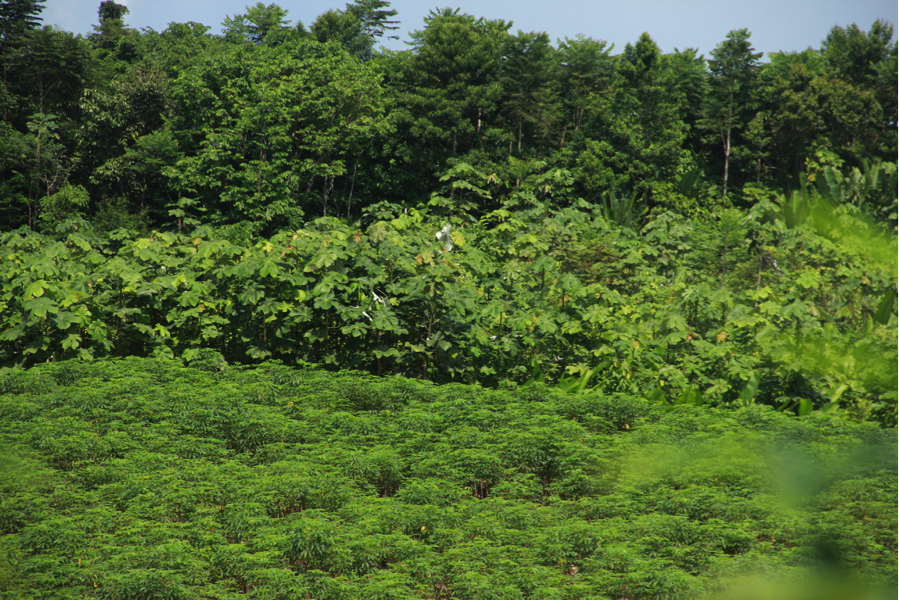- Secondary-growth forests are becoming more common, particularly in the tropics where old-growth forest is often cleared to make way for agriculture.
- A recent study shows that without careful management of farming practices, SFs that regrow on agricultural land in the Brazilian Amazon become less resilient and healthy over time.
- A growing human population places an increasing pressure on the tropics to produce enough food, tropical farmland will need to be carefully managed to ensure long-term productivity.
Look up; look around. Look to the forests in your community. Odds are, they are secondary-growth forests (SFs), forests that regrow following major disturbances. These forests are becoming more common around the world with every passing day, particularly in the tropics where old-growth forest is often cleared to make way for agriculture. A recent study shows that without careful management of farming practices, SFs that regrow on agricultural land in the Brazilian Amazon become less resilient and healthy over time.
More than 21 percent of areas deforested in the Amazon by 2007 regrew into SFs, making this forest type increasingly important in the function of the Amazonian ecosystem, according to the study’s lead author, Catarina Jakovac, a forest ecologist at Wageningen University in the Netherlands. Covering 150,000 square kilometers (58,000 square miles), the majority of these SFs belong to small-scale agricultural operations.
The most common small-scale agricultural practice in this region is swidden, or slash-and-burn, farming. The system functions cyclically: a farmer slashes and burns a tract of forest, farms it, then leaves it fallow and moves on to another tract of land. The cycle length varies, with plots left fallow between two and 15 years before they are slashed and burned anew. In the meantime, trees typically dominate fallow land within a year or two, growing into young SFs.

“[S]econdary forests could play an important role in connecting forest remnants, in protecting soil from erosion and water bodies from silting and in providing goods for people,” Jakovac told mongabay.com. Until now, however, it has been unclear how SFs are affected over time by management practices like swidden agriculture, and the pressures are only increasing.
Recently, population growth in the tropics and related socioeconomic factors have pushed agriculture to its limits. Farmers are using land more intensively than ever in an effort to increase crop production. In tropical swidden agriculture, fallow periods are shrinking, usually to between 2 and 7 years.
In the paper, published in the Journal of Ecology, Jakovac and three colleagues investigated how these shortening fallow cycles affect the resilience of the young secondary forests that grow during them. To do so, the researchers studied 38 forests, all of them about five years old, in five manioc-farming communities along the Tefé River and its tributaries. The researchers studied how varying fallow-period lengths, soil properties, and proximity to old-growth forest affected the SFs’ ability to regenerate.

The researchers found that shortening fallow periods caused a clear decrease in the ability of SFs to regenerate after 5 years. After being used more and more intensely, fallow agricultural lands “become dominated by young secondary forests and by slow-growing and species-poor secondary forests,” Jakovac said.
This was evidenced by the increasing dominance of plants that re-sprout from their roots over plants that must grow from seeds, since sprouting plants do better after major disturbances. This transition from one plant type to another may even permanently alter how forests regrow, according to the paper. Forests may begin, with time and intense management, to look like pastureland.

Soil quality did not affect SF recovery. However, on land subjected to shorter fallow periods the researchers did find that the soil had more sand and rising pH due to increased erosion and cyclical fire.
They also found that SFs located closer to old-growth forest, particularly large tracts of it, had denser foliage and more diverse plants than their farther counterparts, indicating a quicker recovery from agriculture. This underscores the need to consider SFs in land-management strategies, Jakovac said. “To plan more resilient landscapes it is necessary therefore to guarantee the presence of forest corridors and of forest patches within the agricultural landscape and not only surrounding it,” she said.

Over time, the very practice intended to increase crop production in the swidden system — decreasing fallow time — may actually inhibit crop production as total fallow biomass decreases, which limits the soil nutrients available to crops, and as labor demand for weeding increases due to the higher prevalence of fast- growing sprouting plants.
With the world’s human population projected to reach 9.1 billion by 2050, placing increasing pressure on the tropics to produce enough food, tropical farmland will need to be carefully managed to ensure long-term productivity. New management practices may include planting fast-growing crops and excluding strong sprouting plants to speed the recovery of SFs, the paper states.
In addition to their value to the larger ecosystem, SFs also provide diverse resources for local people, from timber to fruits and vegetables. Decreasing SF resilience over time will in turn lead to a depletion of these vital resources, according to the paper. Improved management practices may include more heavily exploiting resources from SFs to reduce pressure on old-growth forests and reliance on agriculture, according to Jakovac and her colleagues.
Whether secondary forests can support life in the same capacity that old-growth forests can remains subject to debate. But Jakovac believes all forests are not created equal. Several crucial processes, such as the conservation of large iconic mammals like jaguars and the maintenance of biogeochemical processes like nutrient cycling, require large, continuous swaths of forest to function properly. “Neither secondary forest patches nor forest fragments can do this job,” Jakovac said.

Citations
- Jakovac, C.C., Peña-Claros, M., Kuyper, T.W., and Bongers, F (2015). Loss of secondary-forest resilience by land-use intensification in the Amazon. Journal of Ecology 103: 67-77.
- Rosenthal,E (2009). New Jungles Prompt a Debate on Rain Forests. The New York Times, 29 Jan. 2009.